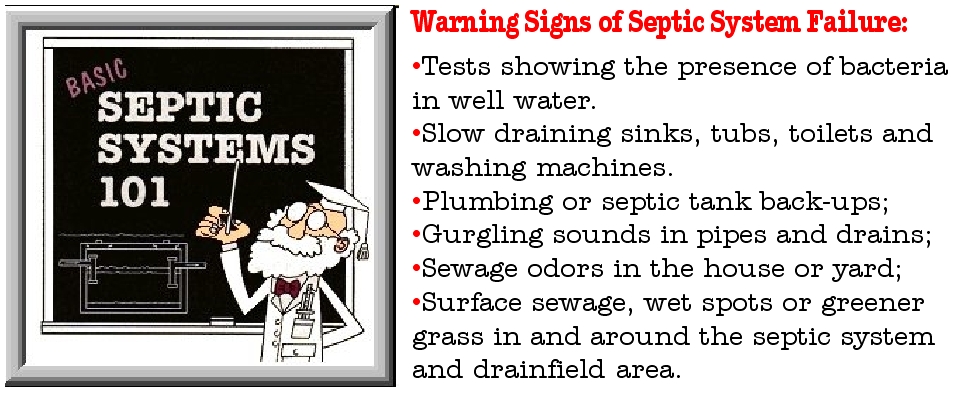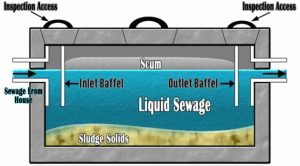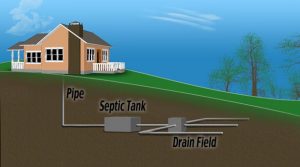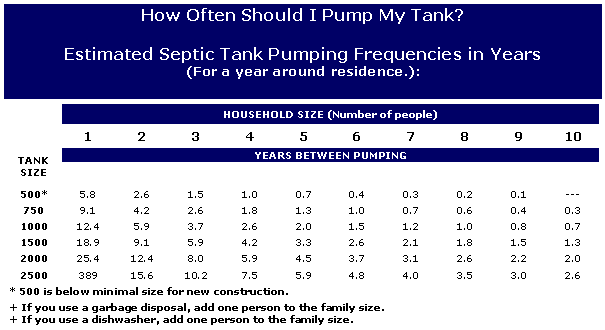 Septic 101
Septic 101
Simple waste water treatment systems consist of a concrete septic tank and a connected network of Perforated Pipes or chambers also known as the drainfield/fieldlines buried in the soil. Sewage from the home flows into the septic tank. In the tank solids settle down to the bottom and wastewater is partially treated by anaerobic micro organisms.
The waste water, also called effluent, leaves the septic tank and flows into the drainfield. As the waste water trickles out of the perforations in the lines, soil borne micro organisms, along with the natural filtering properties of the soil itself, continue the treatment process.
By the time the waste water reenters the ground water supply, it is basically free of pollutants. When septic systems fail, disease-causing pathogens, nutrients, and chemicals can contaminate water supplies.


Q: WHAT EXACTLY IS A SEPTIC TANK?
A: The septic tank is a large container usually buried near the home that receives all of the waste water. Solids settle to the bottom and grease and lighter solids float on the top. Healthy bacteria continually break down these materials and allow effluent water to leave the tank to be dispersed through the leach field. If the water has sludge present, the system is in shut down mode, (failure).
Q: WHERE IS MY SEPTIC TANK LOCATED?
A: The septic tank is usually buried near your house and connected by a sewer pipe to your indoor plumbing. You can find the pipe in the basement, usually 3 to 4 inches in diameter, very carefully remove the end cap and determine the direction of the pipe that leads out to your yard. You can use a flashlight to look through the pipe and a tape to measure the distance to the tank. With this information, you can estimate the location of the tank and then probe carefully with a shovel or iron digging rod to locate the four corners of the septic tank lid and its probable depth.
Q: ARE ALL SEPTIC TANKS THE SAME SIZE?
A: No. Septic tanks are sold in a number of sizes for various applications. If you do not have accurate building or installation records, the tank needs to be uncovered and measured to be sure of its size. Or, your knowledgeable pumping contractor can give you a good estimate.
Q: ARE ALL SEPTIC TANKS MADE OF THE SAME MATERIAL?
A: No. Septic tanks can be made of steel, concrete, or special long-lasting polymer plastic. Steel has no guarantee and deteriorates over time from wastewater, salts and acids, concrete usually has only a one-year maximum factory guarantee and also deteriorates over time from wastewater, salts and acids. The newer polymer septic tanks are guaranteed for many years and are not subject to the deterioration effects of wastewater, salts or acids. Always select the system that gets you the manufacturer’s guarantee that will last the longest when properly installed.
Q: DO SEPTIC TANKS LAST FOREVER?
A: No. Deterioration of both the steel and concrete type of septic tank begins immediately. Polymer tanks last the longest and without physical abuse should serve you well for many, many years. Concrete is porous and cracks by nature. Salts and chemicals are the major factors in deterioration of concrete and metal tanks.
Q: WHAT SHOULD GO INTO MY SEPTIC TANK?
A: The best situation for a long, happy septic tank life would be that only human wastewater enters the tank. This includes bathroom sink waste and proper toilet tissue. This however, is seldom the case. People often put anything and everything down sinks, drains and toilets. In moderation, a properly working septic tank can handle some biodegradable detergents, laundry soaps, kitchen wastes and biodegradable household chemicals. In large amounts, any and all of these things can limit the digestive properties of your septic tank. A good rule of thumb: “If you didn’t, couldn’t, wouldn’t eat it, don’t put it in the septic tank!”
Q: WHAT SHOULD NOT GO IN TO MY SEPTIC TANK?
A: Things like cigarette butts, disposable diapers, sanitary napkins, plastics, any other trash, or high levels of cleaning agents or chemicals create problems for your septic tank. Some things kill the good bacteria the septic tank needs to breakdown human waste. Other items do not readily decompose and more importantly, may clog the baffles and prevent proper fluid flow inside the septic tank. Basically, non-biodegradable products are non-septic products.
Q: HOW CAN YOU TELL IF MY SEPTIC TANK IS WORKING?
A: Visual inspection of your backyard for standing waste water where the leach field should be, or unusual odors might indicate a problem. Otherwise, visual inspection of the septic tank is the first means of checking. Clarity of the effluent water leaving the outlet baffle is most important. Checking and measuring the depths of the sludge, liquid center and top scum level is also important. Checking the temperature and pH of the tank adds more information of the health of the septic tank. Risers on the ports of the lid allow for frequent inspection. Proper pH is a must. Take the reading inside the outlet baffle.
Q: HOW OFTEN SHOULD MY SEPTIC TANK BE PUMPED?
A: Your septic tank should be pumped every two to three years OR when the total depth of sludge and scum exceeds one third of the depth of the tank. Pumping regularly is cost effective because it extends the life of your leach field which would be a major expense to repair or replace.
Q: IS THERE ANYTHING I SHOULD ADD TO MY SEPTIC TANK?
A: Understanding the science of septic dictates what and how much of any additive should be used. New bio-solutions provide greater breakdown of human wastewater and can be formulated to deal with other products found in the septic system to produce a more environmentally safer effluent water to be discharged through your leach field. A reputable dealer trained in these new bio-solutions can offer you more information and provide a maintenance program for implementation.
Q: SHOULD THERE BE ACCESS TO THE TOP OF MY SEPTIC TANK?
A: Yes. In order to inspect and maintain your septic tank, access to the inlet and outlet ports is a must. Risers and childproof access lids can easily be installed to ground level to provide for easy access.
Q: CAN I BUILD OVER MY SEPTIC TANK?
A: It is not recommended ever to build over the septic tank. Access to the tank is necessary for inspection and maintenance. Anything built over the tank would have to be removed for pumping and repairs. Additionally, the weight of anything built over a septic tank could damage the unit. The gasses that might escape are very harmful to people and in a worse case scenario could actually be explosive causing damage to the house and foundation.
Frequently asked questions about leach fields:
Q: WHAT EXACTLY IS A LEACH FIELD?
A: A leach field is any method of leaking the discharge water from the septic tank into the ground. This discharge is from final stage (last outlet from the last septic tank, (sometimes there is more than one tank). In rare situations the effluent may be allowed to be discharged above the ground. The most common leach field is where trenches are dug in the ground in a branching pattern to allow the treated effluent water from the septic tank to be distributed and absorbed. Gravel or stone forms a bed in the trenches for the perforated pipes that connect to the septic tank via a distribution box. Again, this is the most common, but not necessarily the best way to leach the water. Cost and cost to the environment needs to be considered. Proper pretreatment of the wastewater benefits the environment and a long life for the leach field.
Q: ARE ALL LEACH FIELDS BUILT THE SAME WAY?
A: No. Depending on the percolation tests of the area for the leach field a determination is made on the best design for each specific area. Some leach fields are simple trench filled fields dug into the existing ground. Other leach fields are raised beds where proper drainage material is brought in and placed above the existing ground to allow both evaporation and absorption of effluent water.
Q: WHERE WOULD I FIND MY LEACH FIELD?
A: If you do not have access to building plans or records of a septic dealer’s repair of the leach field you might have a difficult time guessing where the entire field is located. Sometimes the lay of the land helps identify where it is located. Other times it would take a measuring snake to identify how long each distribution line is as long as no tree roots or other obstructions have damaged or infiltrated the installation
Q: ARE ALL LEACH FIELDS THE SAME SIZE?
A: No. Depending on the size of the area available to design the field, the obstacles such as buildings, trees, rock or existing water, well location and slope of the land, each field may be unique.
Q: WHY DOES A LEACH FIELD FAIL?
A: The main reason for failure of a leach field is plugging caused by a failed septic tank. Particles of non-decomposed septic material escape the septic tank outlet baffle and decrease the porous nature of the leach field earth. Over time the effluent water may seek relief by bubbling up to the surface since it no longer can be absorbed properly downward into the ground. Offensive odors and dangerous bacteria in the surface water can be identified. Solving the problem of the failed septic tank is the first way to correct this problem. Extending the leach field without addressing the septic tanks problem will only result in extending the problem which will eventually happen again. The best way find the extent of the failure is to ask a trained professional.
Q: WHAT CAN I DO IF MY LEACH FIELD IS ALWAYS WET?
A: Usually this indicates that the leach field has failed and needs immediate attention. Septic bacteria is unsafe for people or pets. The cause for the failure needs to be determined. Plugged leach field lines, groundwater flooding, leaking house water, a failed septic tank, or damage done to the field by excavation or settling all contribute to the failure.
Q: CAN I DRIVE OVER MY LEACH FIELD?
A: No. It is not recommended, but limited driving of light vehicles should not harm a properly installed leach field. Under wet conditions, however, any heavy packing of the earth over the distribution lines will have a negative impact on effectiveness. Avoid having very heavy vehicles such as those used for oil deliveries, pool water filling, cement delivery, etc., ride directly over the field.
Q: CAN I BUILD ON TOP OF THE LEACH FIELD?
A: No, this is not recommended.
Q: CAN I PLANT ANYTHING OVER MY LEACH FIELD?
A: No. Again this is not recommended, but if you must, planting should be limited to annuals and shallow rooted decorative bushes. Larger bushes or trees may send long root systems into the distribution lines and have even been known to grow all the way back and sometimes into the septic tank!
Frequently asked questions about pumping:
Q: WHEN DO I NEED AN EMERGENCY PUMPING?
A: Emergency pumping is needed when you hear strange noises or smell unusual odors coming from your house plumbing. Hopefully, you get the emergency pumping before a nasty backup of septic material into your home. You will still need the emergency pumping but then you also have the unpleasant job and cost of cleaning up a mess that could have been avoided.
Q: HOW OFTEN SHOULD A WORKING SEPTIC TANK BE PUMPED?
A: Honestly, if you were absolutely sure it was fermenting properly and there were no non-biodegradable pollutants in it, it should never have to be pumped. The reality, however, is that often the septic tank is used more like a trash can rather than a properly controlled chemistry project. So you need to do service inspections and regular pumping to prolong the life of your septic leaching system. Trained professionals of the Peace of Mind school offer you the best service for your system. The pumping will remove all of the non-degradable pollutants on the top and bottom of the tank as well as the heavy sludge from the bottom and leave enough of the good-bacterially rich liquid to continue to break down future incoming material. The trained pumping professional will produce a written report on the performance and health of your septic tank and provide you with information on the dos and don’ts to help you keep it working properly. Only a trained professional can correctly assess your usage and present condition of your system to tell you how often you should pump the tank. At a minimum your septic tank should be pumped every two to three years OR when the total depth of sludge and scum exceeds one third of the depth of the tank. Pumping regularly is cost effective because it extends the life of your leach field which would be a major expense to repair or replace.
Q: DO THEY NEED TO DIG UP MY LAWN TO PUMP?
A: Not necessarily. If you already have access to at least the inlet and outlet lids of your septic tank, digging up your lawn will not be necessary. If there is no access to the lid of the septic tank, some digging may be necessary to expose the ports so that the hose can be inserted to remove the septic material. At this time it would be wise to install risers so that digging would not be necessary the next time pumping is required. Pumping cannot and should not be done through the pipe outlet in your basement.
Q: WHY DO THEY NEED TO SEE THE BAFFLES WHEN THEY PUMP?
A: The most important inspection that must be done when a pumping is to check the baffles to make sure that they are not damaged or clogged. The outlet baffle that allows the hopefully clear effluent water to flow to your leach field is by far the most important. This baffle must be intact, structurally solid and free from any debris so that it holds back any solids that might flow into the leach field prior to proper breakdown.
Q: HOW MUCH DOES A PUMPING COST?
A: The cost of pumping varies depending on a number of factors. The size of the tank and the number of gallons of material removed affects the cost. The difficulty to uncover a tank if there are no access ports available. The cost per gallon charged by the receiving facility in your area for the pumping company to dispose of your material.
Frequently asked questions about repairs:
Q: CAN A SEPTIC SYSTEM BE REPAIRED?
A: Yes. Depending upon the problem, many times a repair is possible. Some examples of a repair would be: to fix a crushed or collapsed pipe, , to replace a broken baffle that has allowed solids into the leach field, replace a cracked or collapsed septic tank lid, etc.
Q: WILL A SEPTIC SYSTEM REPAIR SOLVE MY SEPTIC PROBLEMS?
A: Yes and No. Yes, the repair will address an immediate problem that must be taken care of, but No, the repair may not solve the larger septic problems that may have been present before the specific problem that needed repair. It also would not necessarily reverse any problems that were caused because of the specific problem. Every situation is unique and the trained septic dealer will help the homeowner solve all of the septic problems.
Frequently asked questions about environmental issues:
Q: WHAT ENVIRONMENTAL ISSUES ARE MOST IMPORTANT REGARDING SEPTIC SYSTEMS?
A: As population increases in any area, the concern of where, how much, and of what quality septic effluent of these homes has on the environment increases. The simple fact is that all of the septic waste water winds up in the environment. If we are lucky, it is safe and stays where we want it. As it either evaporates or seeps into the earth, we expect it to do no harm to the land, waters of the land and the people who live near.
Q: ARE THERE OTHER IMPORTANT ENVIRONMENTAL CONCERNS?
A: Yes. Drinking water and the protection of the watershed that supplies our drinking water is constantly be compromised. Some of these factors are the population growth and the demands put on the natural resource, the pollutants that get into the water supply from this growth, periodic industrial spill accidents that further damage or make the water supply unfit for human use, and the increase in the number of failed or stressed septic systems.
 The health department recommends having your septic tank pumped every 3 to 5 years. How the septic system is used has much to do with that. For example, the number of people in the home. Is a garbage disposal used?
The health department recommends having your septic tank pumped every 3 to 5 years. How the septic system is used has much to do with that. For example, the number of people in the home. Is a garbage disposal used?
What gets flushed (babywipes, paper towels, children’s toys,etc).
Yes we sometimes even find toys in the tank!!!!!!
Look at the chart from the “Journal of Environmental Engineering.”
